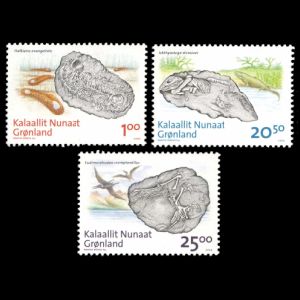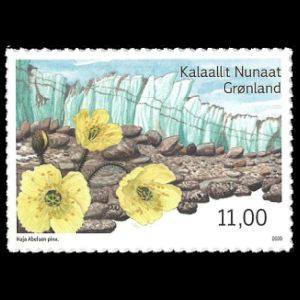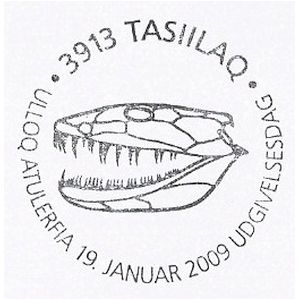the place where Paleontology and Paleoanthropology meets Philately
Greenland (Denmark)
Fossils and reconstruction of prehistoric animals and plants on stamps and postmarks of Greenland
| << previous country | back to index | next country >> |
Contents:
- Country overview
- Philately of Greenland
- Official stamps of Greenland related to Paleontology
- Other stamps of Greenland to consider
- Commemorative postmarks of Greenland related to Paleontology
- References
- Acknowledgement
Greenland, is an autonomous country within the Danish Realm, located between the Arctic and Atlantic Oceans, east of the Canadian Arctic Archipelago. Though physiographically a part of the continent of North America, Greenland has been politically and culturally associated with Europe for more than a millennium.
 |
| Regular letter from Greenland, with stamp of prehistoric plant from 2009, sent to Denmark in 2010. |
Greenland has been inhabited off and on for at least the last 4,500 years by Arctic peoples whose forebears migrated there from what is now Canada.
Norsemen settled the uninhabited southern part of Greenland beginning in the 10th century, and Inuit peoples arrived in the 13th century.
In the early 18th century, Scandinavia and Greenland came back into contact with each other, and Denmark and Norway affirmed sovereignty over the island. [R1]
In 1938, the postal service was established and the first postage stamps of Greenland were issued on November. The series consisted some stamps with a portrait of the Danish king Christian X and two stamps with the image of a polar bear. [R2]
Official stamps of Greenland related to Paleontology: fossils, petrified forest, prehistoric animals and plants
| 06.11.2006 "Science" (II) [1] | 24.05.2008 "Fossils in Greenland" (I) | 19.01.2009 "Fossils in Greenland" (II) |
 |
 |
 |
Notes:
[1] On November 6 2006, Greenland issued the second set of Science stamps (the first set issued in 2005). This set is dedicated to geological and Arctic research.
At least one of the set is relevant to Paleontology: Petrified wood from the Kap Kobenhavn formation [R3] (2.5 Ma), is depicted on the first stamp of the set, face value of 0.50.
A geologist or paleontologist is shown working at the site of the Isua Formation is shown on the second stamp of the set (face value: 8.00). The Isua Greenstone Belt is an Archean greenstone belt in southwestern Greenland. The belt has been dated to between 3.7 and 3.8 Ga, making it one of the oldest rock units in the world. [R4]
The third stamp, face value 15.50, commemorate 100 years Arctic Station at Qeqertarsuaq.
Other stamps to consider: living fossils
| 22.05.2006 "Expeditions in Greenland" (IV) [A4] | 01.10.2007 "Science" (III) [A1] | 19.10.2009 "Centenary of Expedition Otto Nordenskjold" [A2] |
 |
 |
 |
| 28.02.2020 "Kangerlussuaq" [A3] | ||
 |
|
|
Notes:
[A1] The stamp with face value of 10.25 shows an example of living cyanobacteria – these microbes have a fossil record that stretches back to 3.8 billion years ago!
Fossilized Cyanobacteria are known from Stromatolites.
Stromatolites are layered bio-chemical accretionary structures formed in shallow water by the trapping, binding and cementation of sedimentary grains by biofilms (microbial mats) of microorganisms, especially Cyanobacteria.
Fossilized stromatolites provide ancient records of life on Earth by these remains, some of which date from more than 3.5 billion years ago. [R5] [R6]
[A2] Otto Nordenskjöld (1869-1928) was a Finnish and Swedish geologist, geographer, and polar explorer.
In 1902, he discovered Jurassic plant fossils on Seymour Island in Antarctica.
Nordenskjöld became one of the first to suggest that Antarctica must have experienced a much warmer climate in the past, covered by forests of ferns and tropical plants.
For more details please click hier.

|
| Fish fossil from Kangerlussuaq Image credit: polartrec |
[A3] The stamp shows the Arctic deserts at Kangerlussuaq.
The glaciers are melting because of the climate change, climate change, exposes bedrock for study. And these are famous fossil finding place.
Example of fossil found on this place is on the right.
[A4] Alfred Lothar Wegener (1880 -1930) was a German scientist, geophysicist, and meteorologist. He is most notable for his theory of continental drift (Kontinentalverschiebung), proposed in 1912, which hypothesized that the continents were slowly drifting around the Earth.
For more details, please click here.
Commemorative Postmarks of Greenland related to Paleontology: fossils
Legend is here| 24.05.2008 "Fossils in Greenland" (I) [FDC] | 19.01.2009 "Fossils in Greenland" (II) [FDC] | |
 |
 |
|
References:
- [R1] Greenland: Wikipedia WikiTravel FlagCounter
-
[R2] Postal History and Philately of Greenland:
Wikipedia
Links to official website of the Post Authority, stamp catalog and a list of new stamps of Greenland are here - [R3] Kap Kobenhavn formation: Wikipedia
- [R4] The Isua Greenstone Beltn: Wikipedia
- [R5] Cyanobacteria: Wikipedia
- [R6] Stromatolites: Wikipedia
Acknowledgement:
Dr. Peter Voice from Department of Geological and Environmental Sciences, Western Michigan University, for reviewing the draft page and his valuable comments.
| << previous country | back to index | next country >> |